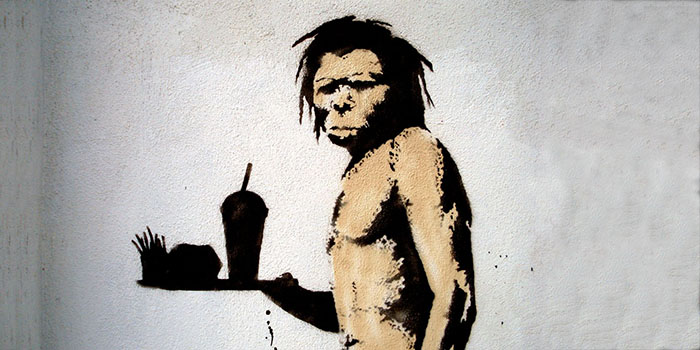
It might be fun to feel all natural or in touch with your human ancestors, but Ken Sayers of theconversation.com has some important news: humans from the Paleolithic area ate whatever they could find. They ate to survive.
Sayers has a good explanation on why we might be tempted to incorrectly class diets from the Paleolithic era:
Reconstructions of human evolution are prone to simple, overly-tidy scenarios. Our ancestors, for example, stood on two legs to look over tall grass, or began to speak because, well, they finally had something to say. Like much of our understanding of early hominid behavior, the imagined diet of our ancestors has also been over-simplified.
Take the trendy Paleo Diet which draws inspiration from how people lived during the Paleolithic or Stone Age that ran from roughly 2.6 million to 10,000 years ago. It encourages practitioners to give up the fruits of modern culinary progress – such as dairy, agricultural products and processed foods – and start living a pseudo-hunter-gatherer lifestyle, something like Lon Chaney Jr. in the film One Million BC. Adherents recommend a very specific “ancestral” menu, replete with certain percentages of energy from carbohydrates, proteins and fats, and suggested levels of physical activity. These prescriptions are drawn mainly from observations of modern humans who live at least a partial hunter-gatherer existence.
But from a scientific standpoint, these kinds of simple characterizations of our ancestors' behavior generally don’t add up.
Through his research, Sayers, who is a Postdoctoral Fellow in Primate and Human Evolution at Georgia State University, found that the trendy view of the Paleo diet as an all-natural, supremely healthful alternative to 21st century nutrition, is a complete hoax.
This isn't to say that the Paleo diet can't give health benefits — that is certainly still possible. But if you're looking to share a diet with your ancestors, it's more likely to look like your buffet than your home garden:
[ Archeological techniques] provide good evidence that plants' underground storage organs (such as tubers), sedges, fruits, invertebrate and vertebrate animals, leaves and bark were all on the menu for at least some early hominids. But they don’t give us information about the relative importance of various foods. And since these foods are all eaten at least occasionally by living monkeys and apes, these techniques don’t explain what sets hominids apart from other primates.
...
Simple characterizations of hominid ecology are divorced from the actual, and wonderful, complexity of our shared history. The recent addition of pastoral and agricultural products to many modern human diets — for which we have rapidly evolved physiological adaptations — is but one extension of an ancient imperative. Hominids didn’t spread first across Africa, and then the entire globe, by utilizing just one foraging strategy or sticking to a precise mix of carbohydrates, proteins and fats. We did it by being ever so flexible, both socially and ecologically, and always searching for the greener grass (metaphorically), or riper fruit (literally).
A hunter-gatherer diet may sound like a better method of sustenance than Taco Bell's newest Triple Steak Stack (don't tell me it isn't real steak; I refuse to believe that myth), but you're just as close to the diet of a Paleolithic man when you go through a drive through as you are when you eat only meat, nuts, and berries.
The full article can be found here.
Header image via flickr, Lord Jim. Art by Banksy








